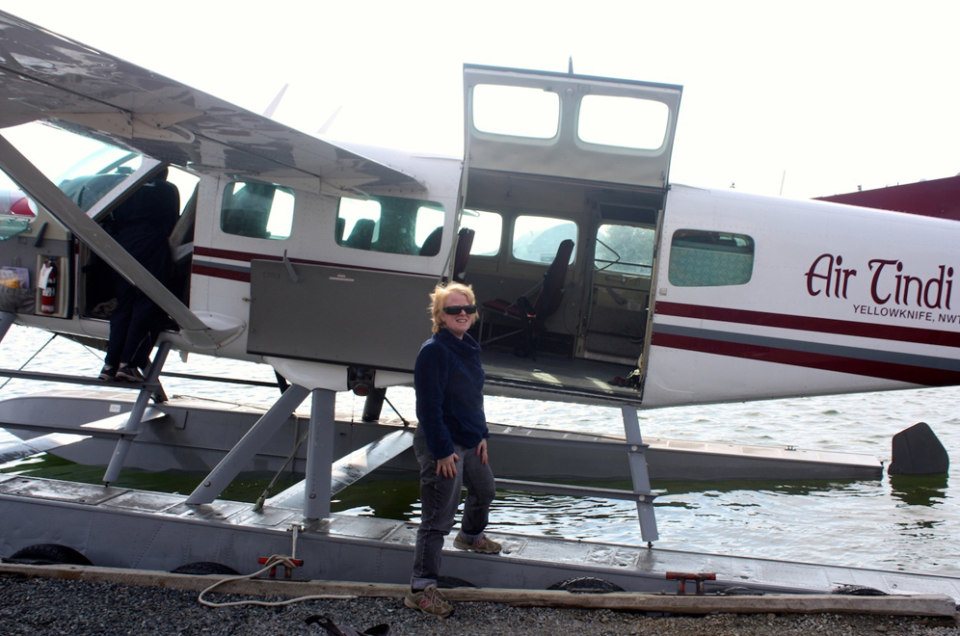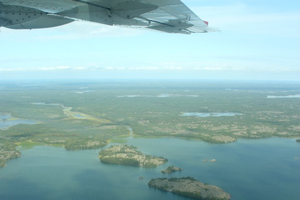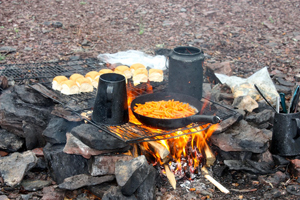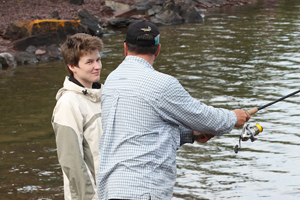Former restaurateur Carlos Gonzalez is a bundle of nervous energy as he rushes through the doors of the Air Tindi floatplane base in Yellowknife’s Old Town. With his dark glasses, trench coat, moustache and ruddy complexion, he looks more like a detective from a 1940s Hollywood movie than a seasoned chef and the owner of Yellowknife Outdoor Adventures. He and his five guests are heading out on a half-day flight-seeing tour of the East Arm of Great Slave Lake and a cooked lunch on an isolated beach.
But first everyone gathers around a large map of the Northwest Territories that’s plastered on one wall. Steve is a lanky, unassuming bespectacled young pilot with about a decade of flying under his belt. But he looks like he would be just as comfortable sitting at a computer. He points to spots on the map as he describes our route to the East Arm.
Great Slave Lake is the deepest freshwater lake in North America. At 300 miles long and as much as 68 miles wide in some places, it’s also the second largest lake in the Northwest Territories. Land has been set aside at the lake’s eastern end to create the proposed Thaidene Nene National Park Reserve. “Thaidene Nene” means “land of our ancestors” in the Chipewyan language. The East Arm’s rugged landscape features boreal forest and tundra, islands, canyons and dramatic cliffs that drop nearly 200 feet.
After getting the lowdown on our flight path, we traipse outside to the seven-seat Caravan floatplane. One by one, we carefully straddle the small space between the dock and the bottom rung of the plane. Then we climb up and grab a seat inside. As we’re pulling away from the dock, Carlos looks out the window at a kayaker sitting on the water. “I bet you he’s German,” he says. “Say something to him in German,” he tells Britta, a twenty-something German accountant who is riding shotgun with the pilot. She complies – and a brief conversation with the kayaker ensues in their native tongue. “Told ya,” Carlos says after she shuts the window. “He looks German.”
The plane’s pontoons skim the surface of the water of Yellowknife Bay as we take off.
At first, we circle over the city skyline, the shaft of the former Con Mine and frothy Cameron Falls. Then the rocky landscape around the territorial capital gives way to boreal forest and tundra. The aquamarine water of Great Slave Lake is framed by a green landscape pockmarked with small lakes.
The only interruptions are a group of abandoned buildings from a former gold mine near François Lake. Then, at Plummer’s Lake Lodge an airstrip long enough to land a 747 airplane appears below us like a long finger. I idly wonder what a planeload of tourists deposited in the middle of this barren landscape would think. We continue cruising. Steve is looking for the perfect place to land for lunch. About 10 minutes later he taxis to the edge of a small, pebbly beach with a dreamy view. There’s nothing out here in the middle of the wilderness but Mother Nature and whatever bush you nominate to be your outhouse.
The pilot ties down the plane and we unload the gear. Carlos piles up rocks, grabs wood from a green bin he brought along, and builds a fire. He rifles through a blue tub of fixings for lunch. Soon, spicy carrots are cooking in a pan. Two pots of water sit heating up on either side like tall metal bookends. Carefully seasoned lake trout is frying away on two rectangular cookie sheets, while a grate holds a dozen golden homemade rolls.
Brian, wanting to be a helpful guest, starts flipping the buns. “Let them crisp up,” Carlos barks, like a chef talking to a line cook. This isn’t foreign territory for our host. The former Montrealer, who moved to the North more than 30 years ago, has worked for Fairmont Hotels, Yellowknife’s Explorer Hotel and owned a restaurant. He’s a guy who’s used to running a kitchen – even if it doesn’t have walls.
We grab plates from a metal fold-up table and load up on carrots, fish, salad, and buns. Then desserts magically appear from the blue plastic bin. As Carlos arranges them on a plate, I ask him to hold up the treats so that I can take a photo. He straightens up, balances the plate over his left hand and gives me a mischievous grin. “You know that this is the perfect position for pie-ing someone,” he says. For a split second I wonder if I’m about to get a chocolate-cake facial infused with flecks of lemon pound cake. Then I relax.
Once our bellies are full, we walk to the water’s edge for a fishing lesson. Gripping the rod, I pull it back against my shoulder and then toss the line as far forward as my little matchstick arms can muster. Then I reel it in. Again. And again. And again. Good thing Carlos brought the fish. We would’ve starved if he’d relied on me to catch lunch. The only thing I manage to catch is air. Shannon walks carefully along one of the plane’s pontoons and casts her line off the end. She doesn’t have any luck, either. Clearly, the ingredients for our next meal will have to come from a grocery store in Yellowknife.
As we fly back toward the territorial capital, the sun and shadows play hopscotch on the emerald water and land below us. Then, the barren landscape magically disappears. The shaft of the former Con Mine sticks up through Yellowknife’s skyline. Boats on Yellowknife Bay look like children’s toys. Buildings on a rocky outcrop get closer. Then the plane pulls up to the Air Tindi dock and we all climb out.
I rub my eyes and look around. Then, as quickly as he appeared four hours earlier, Carlos departs into civilization like a stealthy Hollywood detective. But that sense of having been entertained by a good host and enchanted by the beauty of a landscape remains.



